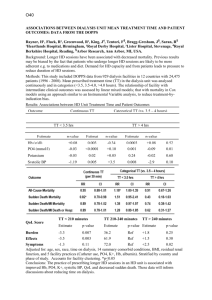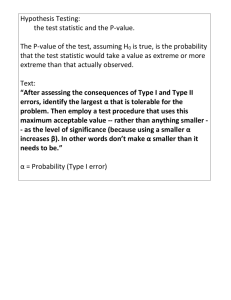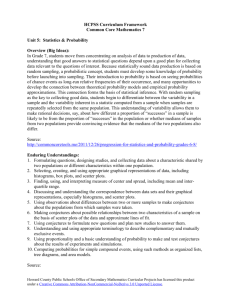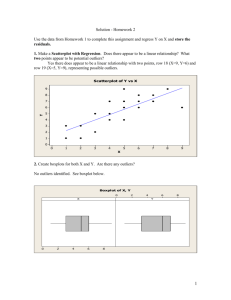THE RISK OF RANDOM ERROR (PLAY OF CHANCE)
advertisement
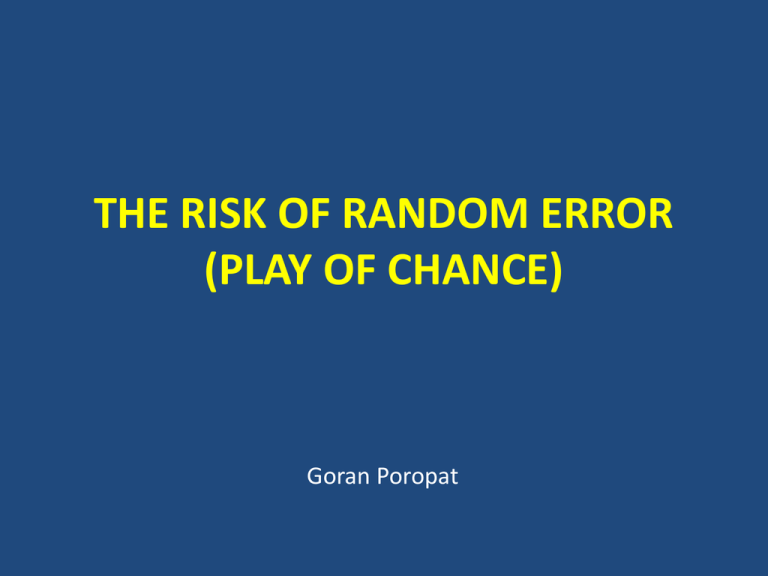
THE RISK OF RANDOM ERROR (PLAY OF CHANCE) Goran Poropat Introduction No physical quantity can be measured with perfect certainty All measurements are prone to errors Experimental errors Do not refer to mistakes, blunders, or miscalculations (eg. measuring a width when the lenght should have been measured) Inherent in the measurement process Experimental errors Are measured by a) Accuracy – how close a measured value is to the true value or accepted value b) Precision – how closely two or more measurements agree with each other (repeatability, reproducibility) Experimental errors Three dimensions particularly influence the reliability of our observations in clinical research: 1. RANDOM ERRORS (PLAY OF CHANCE) 2. SYSTEMATIC ERRORS (BIAS) 3. DESIGN ERRORS Bias A systematic error – deviation from the truth, in results or inferences Overestimation or underestimation of the true intervention effect Bias Affect accuracy of a measurement Should not be confused with imprecision Multilpe replications of the same study – wrong answer on average Random error Imprecision – refers to random error The unpredictable variation between observed values and some “true” value Possible reason of misleading results in RCTs and meta-analyses Random error Affects precision of measurement Multilpe replications of the same study Different effect estimates SAMPLING VARIABILITY Sampling variability The actual study result will vary depending on who is actually in the study sample A sample – a subset of a population of manageable size Epidemiological studies Impossible to evaluate every member of the entire population The relationship between exposure and healthrelated event is judged from observations on a SAMPLE of the population STATISTICAL INFERENCES (extrapolations) Sampling variability 50 x x 50 N=4 2x 2x x4 Sampling variability Different inferences – various possible samples Hypothesis Information size Probability of drawing a bad sample Random errors tend to decrease as information size increases Sampling variability RR Clinically important overestimate! q 1 Number of patients randomised Required sample size Epidemiological studies The measure of association we observe (inference) in our data may differ from the “true” measure of association - by chance alone Probability that the observed difference is due to play of chance Hypothesis testing Quantify the degree to which sampling variability (chance) can explain the observed association Assume H0 is true, and not Ha Assessing H0 P-value The probability of obtaining an observed effect (or larger) under a null-hypothesis P-value The likelihood of observing certain data given that the null-hypothesis is true P-value threshold = 0.05 – arbitrary Data yielding a P-value = 0.05 – a 5% chance obtaining the observed result, if no real effect exists P-value A P-value is the probability of an observed (or more extreme) result arising by chance Misinterpretations P>0.05 “the intervention has no effect” “not strong evidence that the intervention has an effect” P<0.05 “ an intervention has a strong benefit” The P value addresses the question of whether the intervention effect is precisely nil Confidence intervals Another approach to quantify sampling variability Range within which the true magnitude of effect lies with a stated probability, or a certain degree of assurance (usually 95%) Confidence intervals Point estimate – the actual measure of association given by the data (OR, RR, RD) The best guess of the magnitude and direction of the experimental intervention’s effect compared with the control intervention Confidence intervals Wider intervals – greater imprecision CI width • Sample size • Precision of individual study estimates • Number of studies combined Confidence intervals P-value – to which extent the null-hypothesis is compatible with the data CI – the range of hypothesis compatible with the data Sum up • Random error (due to ’play of chance’) is the unpredictable variation between observed values and some ’true’ value • Everything we attempt to estimate may be subject to some degree of random error Sum up • Random error affects • Statistical significance • Estimated treatment effects • Heterogeneity estimates • Only a sufficient number of trials and patients will ensure an acceptable risk of random error Thank you for your attention!



